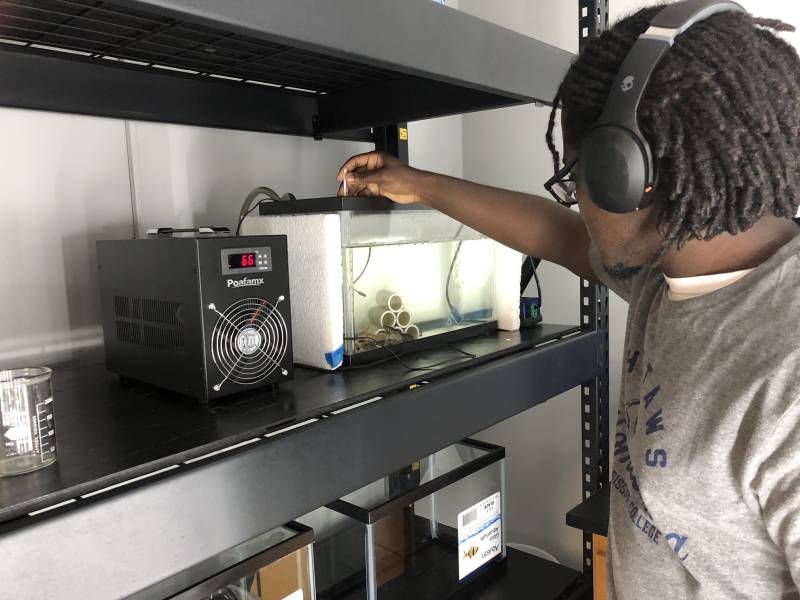MC Research Team Studies Popular Spring Food to Reveal Lithium’s Potential Environmental Impact

Lithium-ion rechargeable batteries power a plethora of devices, from cell phones to watches to electric automobiles. As consumers discard electronic products, more lithium could find its way into the environment.
Researchers at Mississippi College are exploring how lithium can accumulate in a common Southern crustacean: the crawfish.
As the season for catching and eating “mudbugs” comes into full swing, findings by Joseph Kazery, assistant professor of biology at MC, and Andrew Doubert and Javian Ervin, a pair of undergraduate students in his lab, highlight potential implications for public health and the environment.
The researchers presented their results March 20 at the spring 2024 meeting of the American Chemical Society. The hybrid meeting featured nearly 12,000 presentations on a range of scientific topics.
To view a video about their research, click here.
“As equatic organisms, crawfish can take up large amounts of lithium dissolved in water,” Kazery said. “Because other creatures – including people – eat crawfish, looking at them allows us to see how lithium moves through the food chain and potentially into us.”
Doubert and Ervin presented the results of their experiments on the uptake of ionic lithium by different crawfish organs, as well as the impact of seasonal temperatures.
“If crawfish are raised near a landfill or a polluted site, runoff could expose them to lithium, with effects we don’t yet fully understand,” Ervin said. “I eat crawfish, so this issue is important to me.”
Lithium contamination is not new. Even before lithium-ion batteries became widespread, lithium was – and still is – used as a medication to treat mood disorders.
Lithium enters the water supply because typical wastewater treatment does not remove drug contaminants. At high levels, lithium can have toxic effects on human health, including potentially damaging heart muscle cells and causing confusion and speech impairment.
In other animals, lithium can cause kidney damage and hypothyroidism. Kazery said that studies have shown that when lithium accumulates in plants, it can inhibit their growth.
Although the U.S. Environmental Protection Agency recommends discarding lithium-ion batteries at dedicated collection points, Kazery said they often end up in landfills instead. He said soaring demand for the batteries and lax disposal practices suggest lithium is on the verge of becoming a significant environmental contaminant.
As fully aquatic organisms that spend their lives within a relatively small area, crawfish reflect local lithium contamination and could serve as powerful bioindicators of its presence in an environment. The lithium crawfish contain could be passed through the food chain to predators, including humans, directly or indirectly through crawfish-eating fish that people consume.
For the experiments, Kazery and his team purchased crawfish bred for research. Knowing that the liver collects toxins from the human body for subsequent removal, Doubert wondered whether lithium would accumulate in the crawfish version of the hepatopancreas.
To find out, he added ionic lithium to food for five crawfish, while giving another five lithium-free food. He then examined the amount of lithium present in four of their organs after one week.
Doubert found, on average, the most lithium in the gastrointestinal tracts, followed by the gills, the hepatopancreas, and, finally, the abdominal muscle in the tail.
The researchers think the GI tract likely contained the highest level because the lithium-spiked food remained there during digestion. Meanwhile, the gills and the hepatopancreas both pick lithium up while removing it from the body.
People predominantly eat the tail, which appears to take up lithium, but not as readily as the other body parts the team studied.
Doubert also found that 27.5 percent of the lithium he fed to the crawfish had passed from the animals’ GI tracts into other tissues. Animals further up the food chain can accumulate higher levels of toxic substances if they eat contaminated prey, so lithium will likely become more concentrated in predators of crawfish.
The researchers expect the high rate of lithium absorption Doubert saw to exacerbate this accumulation in both humans and other animals that eat crawfish.
Water temperature that crawfish inhabit varies significantly throughout the year. Those shifts affect the animals’ metabolism, even causing them to become inactive during winter.
Ervin decided to look at the effects of temperature on lithium uptake. He placed crawfish in tanks kept at temperatures as low as 50 degrees Fahrenheit and as high as 90 degrees Fahrenheit and added a consistent concentration of ionic lithium to the water.
After five days, he found that lithium uptake by the abdominal muscle and a part of the crawfish that Doubert did not study — the animals’ exoskeleton — increased in the warmest tank. These results suggest that abdominal uptake still occurred without ingestion and that the animals may contain the most lithium during the warm months, according to Ervin.
The crawfishes’ weight also decreased in warmer water. At this point, it’s not clear how or whether their weight loss was connected to the lithium they accumulated, Ervin said, although the team plans to follow up on these results.
“A lot of people think the use of lithium-ion batteries is a good thing right now,” Doubert said. “But it is important to explore the effects that may be coming down the road.”
The research was funded by Mississippi College’s Department of Biological Sciences and the Office of Research, Department of Student Research.
The ACS is a nonprofit organization chartered by the U.S. Congress. Its mission is to advance the broader chemistry enterprise and its practitioners for the benefit of Earth and all its people.
The society is a global leader in promoting excellence in science education and providing access to chemistry-related information and research through its multiple research solutions, peer-reviewed journals, scientific conferences, eBooks, and weekly news periodical, “Chemical & Engineering News.”
As a leader in scientific information solutions, its CAS division partners with global innovators to accelerate breakthroughs by curating, connecting and analyzing the world’s scientific knowledge. ACS’ main offices are in Washington, D.C., and Columbus, Ohio.
Sign-up For Our Newsletter
Get the latest news about Mississippi College delivered right to your inbox by subscribing to the Along College Street e-newsletter.


